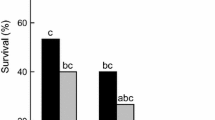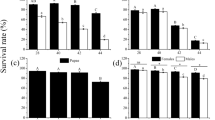Summary
Exposing diapausingDelia radicum (L.) to temperatures from-10.2 to-14.8° C during a 80-day experimental period reduced survival to eclosion and the rate of postdiapause development. No such effects occurred among those exposed to-7.1° C for up to 80 days. A continuous exposure to-10.2 or-14.8° C reduced survival of overwinteringD. radicum by the same amount as an equal duration of exposure to these temperatures interrupted by 14 days at 2° C, indicating that the effects of cold exposure were additive and that repair of cold-induced injuries did not occur at 2° C. The decreased survival with increasing duration of exposure to-10.2 or-14.8° C were described by the equations:
Wherep=the proportion surviving to eclosion andt=the number of days of exposure to the temperature given by the subcript. An increased incidence of malformed adults was associated with low survival. Adult emergence occurred within two periods. Early-emerging flies required up to 230° D and late-emerging flies more than 330° D above 5.6° C. Among early-emerging flies, a reduced rate of postdiapause development was associated with low survival but the development of late-emerging flies was not affected.
OverwinteringD. radicum parasitized byTrybliographa rapae (Westw.) or byAleochara bilineata Gyll. responded similarly to unparasitizedD. radicum although those parasitized byT. rapae were less resistant to cold injury when exposed to-14.8° C.
D. radicum and its parasitoids are capable of surviving temperatures more severe than those normally occurring in England and Wales; and, therefore, cold injury is unlikely to affect their population dynamics.
Similar content being viewed by others
References
Ashton WD (1972) The logit transformation. Hafner, New York
Coaker TH, Finch S (1971) The cabbage root flyErioschia brassicae (Bouche). Ann Rpt (1970) Nat Vegetable Res Sta Wellesbourne, UK, pp 23–42
Coaker TH, Wright DW (1963) The influence of temperature on the emergence of the cabbage root flyErioschia brassicae (Bouche) from overwintering pupae. Ann Appl Biol 52:327–343
Collier RH, Finch S (1983a) Completion of diapause in field populations of the cabbage root fly (Delia radicum). Entomol Exp et Appl 34:186–192
Collier RH, Finch S (1983b) Effects of intensity and duration of low temperatures in regulating diapause development of the cabbage root fly (Delia radicum). Entomol Exp et Appl 34:193–200
Commonwealth Institute of Entomology (1983) Distribution maps of pests.Delia radicum (L). Map No 83
Davies JW (1974) Averages in soil temperatures at 10 and 20 cm depth 1959–1968. London Meteorological Office, Agric Mem. No. 646. (Unpublished memorandum available from National Meteorological Library, Bracknell, Berks, England)
Finch S, Skinner G (1980) Mortality of overwintering pupae of the cabbage root fly (Delia brassicae). J Appl Biol 17:657–665
Hare FK, Thomas MK (1979) Climate Canada, 2nd ed. Wiley, Canada Toronto
Liu HJ, Butts RA (1982)Delia spp. (Diptera: Anthomiidae) infesting canola in Alberta. Can Entomol 114:651–653
Makarenko GN (1968) Resistance to cold inTrybliographa rapae West (Cynipidae) and its host, the spring and summer cabbage flies. Trudy Vsesoyuznogo Inst Zashchity Rastenii 31:276–288 (in Russian, English summary)
Mukerji MK (1971) Major factors in survival of the immature stages ofHylemya brassicae (Diptera: Anthomyiidae) on cabbage. Can Entoml 103:717–728
Richard OW, Davies RG (1977) Imm's general textook of entomology, 10th ed. Vol 1, Structure, physiology and development. Chapman and Hall, London
Snodgrass RE (1954) The metamorphosis of a fly's head. Smithsonian Misc Coll 122: No. 3, 25 pp
Turnock WJ, Lamb RJ, Bodnaryk RP (1983) Effects of cold stress during pupal diapause on the survival and development ofMamestra configurata (Lepidoptera: Noctuidae). Oecologia (Berl) 56:185–192
Author information
Authors and Affiliations
Additional information
Contribution No. 1153, Agriculture Canada Research Station, Winnipeg, Manitoba
Rights and permissions
About this article
Cite this article
Turnock, W.J., Jones, T.H. & Reader, P.M. Effects of cold stress during diapause on the survival and development ofDelia radicum (Diptera: Anthomyiidae) in England. Oecologia 67, 506–510 (1985). https://doi.org/10.1007/BF00790021
Received:
Issue Date:
DOI: https://doi.org/10.1007/BF00790021




